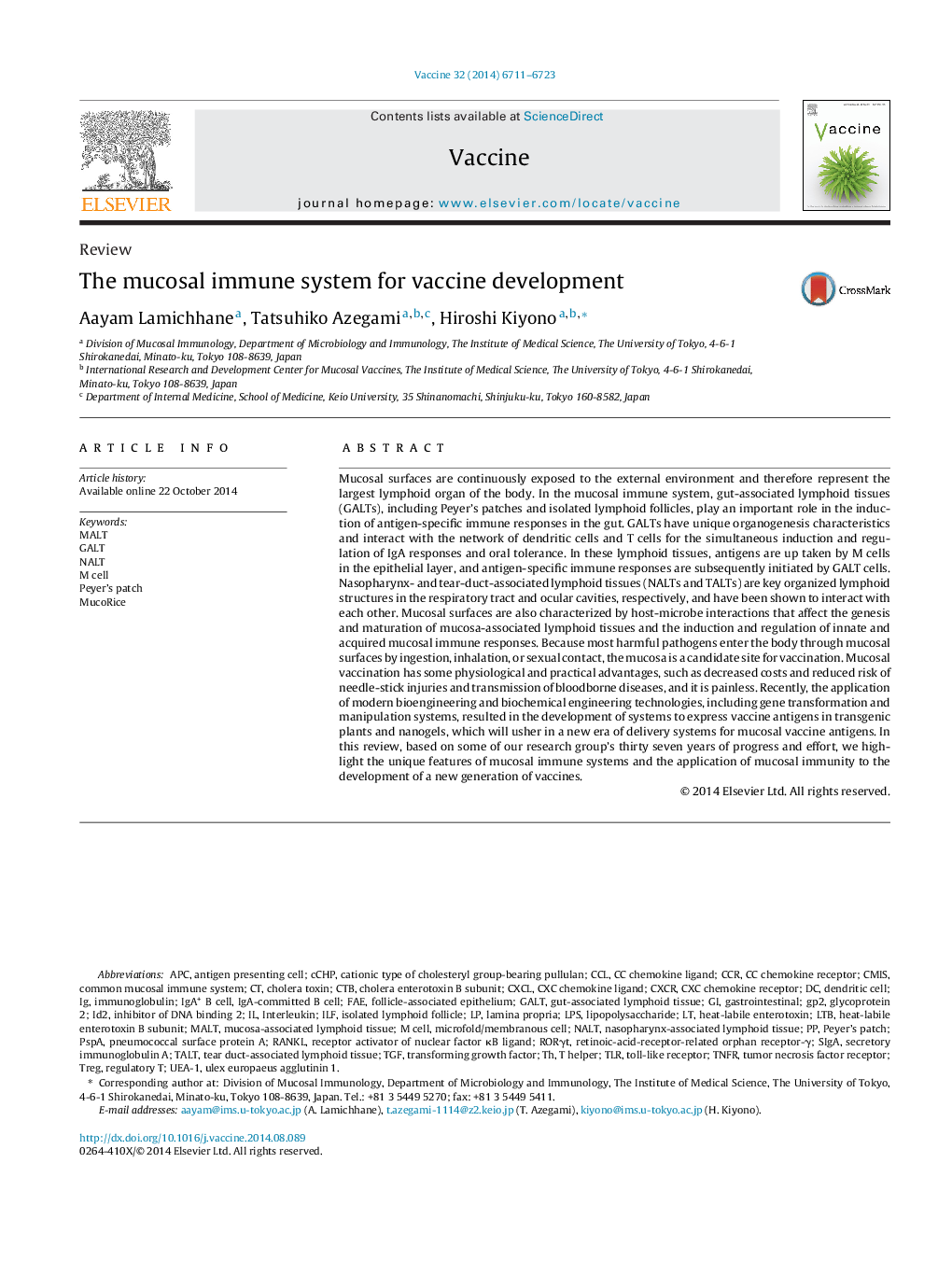| کد مقاله | کد نشریه | سال انتشار | مقاله انگلیسی | نسخه تمام متن |
|---|---|---|---|---|
| 10964149 | 1102705 | 2014 | 13 صفحه PDF | دانلود رایگان |
عنوان انگلیسی مقاله ISI
The mucosal immune system for vaccine development
ترجمه فارسی عنوان
سیستم ایمنی مخاطی برای توسعه واکسن
دانلود مقاله + سفارش ترجمه
دانلود مقاله ISI انگلیسی
رایگان برای ایرانیان
کلمات کلیدی
RORγtCCLTregId2CXCLTNFRPspAT helperCXCRFAELPSInhibitor of DNA binding 2cMISILFGP2Nasopharynx-associated lymphoid tissueUEA-1CCHPCommon mucosal immune systemUlex europaeus agglutinin 1TGFCTBGALTRANKLLTBAPCTLRCCRNALT - NaltësIgA - sAgAheat-labile enterotoxin - انتروتوکسین گرم لابلیfollicle-associated epithelium - اپیتلیوم مرتبط با فولیکولimmunoglobulin - ایمونوگلوبولینsecretory immunoglobulin A - ایمونوگلوبولین A ترشحیinterleukin - اینترلوکینMucosa-associated lymphoid tissue - بافت لنفاوی مرتبط با مخاطgut-associated lymphoid tissue - باکتری لنفوئیدی مرتبط با رودهtransforming growth factor - تبدیل فاکتور رشدToll-like receptor - تیالآرGastrointestinal - دستگاه گوارشM cell - سلول MDendritic cell - سلول دندریتیکantigen presenting cell - سلولهای پردازنده آنتیژنcholera toxin - سوزش گوارشیIsolated lymphoid follicle - فولیکول لنفاوی جدا شدهLamina propria - لامینا پروپریاlipopolysaccharide - لیپوپلی ساکاریدCXC chemokine ligand - لیگاند شیمیایی CXCCC chemokine ligand - لیگاند کیموکین CCMalt - مالتRegulatory T - مقررات TPneumococcal surface protein A - پروتئین سطح Pneumococcal APeyer's patch - پیک پچglycoprotein 2 - گلیکوپروتئین 2CXC chemokine receptor - گیرنده شیمیایی CXCtumor necrosis factor receptor - گیرنده فاکتور نکروز تومورCC chemokine receptor - گیرنده کیموکین CCReceptor activator of nuclear factor κB ligand - گیرنده گیرنده فاکتور هسته ای κB لیگاند
موضوعات مرتبط
علوم زیستی و بیوفناوری
ایمنی شناسی و میکروب شناسی
ایمونولوژی
چکیده انگلیسی
Mucosal surfaces are continuously exposed to the external environment and therefore represent the largest lymphoid organ of the body. In the mucosal immune system, gut-associated lymphoid tissues (GALTs), including Peyer's patches and isolated lymphoid follicles, play an important role in the induction of antigen-specific immune responses in the gut. GALTs have unique organogenesis characteristics and interact with the network of dendritic cells and T cells for the simultaneous induction and regulation of IgA responses and oral tolerance. In these lymphoid tissues, antigens are up taken by M cells in the epithelial layer, and antigen-specific immune responses are subsequently initiated by GALT cells. Nasopharynx- and tear-duct-associated lymphoid tissues (NALTs and TALTs) are key organized lymphoid structures in the respiratory tract and ocular cavities, respectively, and have been shown to interact with each other. Mucosal surfaces are also characterized by host-microbe interactions that affect the genesis and maturation of mucosa-associated lymphoid tissues and the induction and regulation of innate and acquired mucosal immune responses. Because most harmful pathogens enter the body through mucosal surfaces by ingestion, inhalation, or sexual contact, the mucosa is a candidate site for vaccination. Mucosal vaccination has some physiological and practical advantages, such as decreased costs and reduced risk of needle-stick injuries and transmission of bloodborne diseases, and it is painless. Recently, the application of modern bioengineering and biochemical engineering technologies, including gene transformation and manipulation systems, resulted in the development of systems to express vaccine antigens in transgenic plants and nanogels, which will usher in a new era of delivery systems for mucosal vaccine antigens. In this review, based on some of our research group's thirty seven years of progress and effort, we highlight the unique features of mucosal immune systems and the application of mucosal immunity to the development of a new generation of vaccines.
ناشر
Database: Elsevier - ScienceDirect (ساینس دایرکت)
Journal: Vaccine - Volume 32, Issue 49, 20 November 2014, Pages 6711-6723
Journal: Vaccine - Volume 32, Issue 49, 20 November 2014, Pages 6711-6723
نویسندگان
Aayam Lamichhane, Tatsuhiko Azegami, Hiroshi Kiyono,
